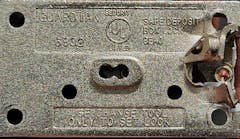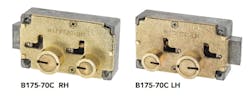In order to do great work with safe locks, perhaps the most important thing to know is how the locks work. Whether you’re diagnosing a malfunction, opening a safe with an unknown combination or performing maintenance or repairs, a thorough understanding of lock functionality is likely to take you much farther than any other information you could get your hands on.
So, in the interest of furthering education on that topic, this article will document the operational functionality of a few locks. These are combination locks that I currently have in my possession: a Kromer 8567, a Diebold 900, and an Ilco 6731. They are similar in function, in that each is a three-wheel, direct-drive combination lock of fairly typical high-level design. But even among these locks. there are significant differences that safe technicians should recognize.
KROMER 8567
The Kromer 8567 appears in Figure 1 with its original black, textured paint. Figure 2 shows the inside. The lock case’s interior has its original red paint job, but I’ve embellished most of the other parts to make them a little more fun to look at. An exploded view can be seen in Figure 3, with each part labeled by letter. * Each wheel is numbered according to which portion of the combination it applies. The fist number of the combination is determined by wheel 1, the second by wheel 2, and so on. This is an industry-wide standard. Kromer stamped these numbers on the wheels of their locks, but the only difference between wheels 2 and 3 is the stamped number. I number each fly according to the number of the wheel in which it is installed.
Parts C through H are known collectively as the wheel-pack. Now let’s examine some critical sub-components of certain parts. Figures 4 and 5 show the lock case and fence lever.
Notice that each of the isolation washers has a small extension along its inner circumference. That extension goes into a groove in the wheel-post, preventing the isolation washers from rotating. They separate all of the other wheel-pack components from each other and also inhibit the transfer of motion between them. This inhibition is what distinguishes isolation washers from simple spacers. This lock’s spacer (part B) seems to serve no purpose other than to reduce friction by preventing the wheels from rubbing the lock case. The lever post (K.2) extends through the lock-bolt and into the lever-post channel (A.4), limiting the lock-bolt’s range of motion. That way the lock-bolt can neither enter the lock case completely nor exit it completely as long as the lever post is in place.
Figure 6 shows a wheel. This one happens to be wheel 3. On this side of the wheel, there is a depression to make room for the wheel’s fly. The fly is free to rotate within this depression, without moving the wheel, until the fly contacts one of the two fly stops.
Now look at the other side of that wheel, Figure 7, to see its integrated drive pin. Wheel 2 also has a drive pin, as does the drive cam. But note that wheel 1 has no drive pin. (It doesn’t need one because wheel 1 doesn’t drive any other wheels.)
The dial spindle goes through the wheel-pack and threads into the drive cam. A spline key keeps the spindle and cam fastened together, as shown in Figure 8. The three-number combination is dialed as follows:
Turn the dial left (counter-clockwise) till the fourth time that the first number aligns with the opening index on the dial ring. This aligns wheel 1’s gate under the fence.
When the dial and drive cam rotate counter-clockwise, the cam’s drive pin pushes fly 3 counter-clockwise. When the fly reaches the left fly stop of wheel 3, it pushes the wheel counter-clockwise. At some point before wheel 3 completes one full rotation, wheel 3’s drive pin contacts fly 2. When fly 2 reaches the left fly stop of wheel 2, it pushes the wheel counter-clockwise. Sometime within one rotation of wheel 2, the wheel contacts fly 1 and begins pushing it. When fly 1 reaches the left fly stop of wheel 1, it begins pushing wheel 1. At this point the drive cam has made no more than three rotations counter-clockwise, and all of the wheels are moving together. So the user can now be sure that he is moving wheel 1 and thus will be ready to stop the next time he reaches the 1st number of the combination.
Turn the dial right until the third time that the second number aligns with the opening index. This aligns wheel 2’s gate under the fence without moving wheel 1.
When the dial and drive cam rotate clockwise, the cam’s drive pin pushes fly 3 clockwise. When the fly reaches the right fly stop of wheel 3, it pushes the wheel clockwise. At some point before wheel 3 completes one full rotation, wheel 3’s drive pin contacts fly 2. When fly 2 reaches the right fly stop of wheel 2, it pushes the wheel clockwise. At this point the drive cam has made two full rotations clockwise, and wheels 3 and 2 are now moving together. So the user can now be sure that he is moving wheel 2 while leaving wheel 1 in place, and thus will be ready to stop the next time he reaches the 2nd number of the combination.
Turn the dial left until the second time that the third number aligns with the opening index. This aligns wheel 3’s gate under the fence without moving wheels 1 and 2.
When the dial and drive cam rotate counter-clockwise, the cam’s drive pin pushes fly 3 counter-clockwise. When the fly reaches the left fly stop of wheel 3, it begins to push the wheel counter-clockwise. At this point the drive cam has made one full rotation counter-clockwise, and wheel 3 is now moving independently of the other wheels. The user will be ready to stop the next time he reaches the third number of the combination.
Turn the dial right until it comes to a complete stop. This retracts the lock-bolt.
When the dial and drive cam rotate clockwise, the cam’s gate aligns with the lever nose. This allows the lock case’s integrated lever spring to press the fence lever into the drive cam. The fence is an integral part of the lever that cannot enter the wheel-pack unless every wheel’s gate is aligned directly under the fence. The lever nose, therefore, cannot fully enter the drive cam’s gate unless the correct combination has been dialed. Since the combination has already been dialed to align the wheel gates, the lever nose fully enters the cam’s gate and the lever side-steps the lever stop. When the cam rotates further clockwise, it pulls the lock-bolt into the lock case. The lock is now unlocked.
Notice in the exploded view of this lock that all of the wheels and flies are separated from each other by isolation washers, which are unable to rotate. The isolation washers prevent these parts from transferring motion to each other through friction, as they should only be moved by contact between drive pins, flies, and fly stops. This is very important. If parts are moved by friction, then wheels won’t stay where they’re parked. For example, wheel 1 may move when the user is setting wheel 2. This is known as “wheel dragging,” and it would prevent the correct combination from properly aligning the wheels, so the lock wouldn’t unlock reliably.
DIEBOLD 900
A Diebold 900 is shown in Figure 9 with a “jeweled” and “jiggered” exterior, but it came from the factory as dull, unfinished bronze. This lock has two cover screws. Figure 10 shows the inside of the lock. This lock’s mounting footprint is slightly larger than the Kromer’s, and this one’s lock-bolt is narrower. The dial spindle fastens to the drive cam in the same way, but the spindle is smaller in diameter at a mere quarter-inch. The lock case’s interior now has a bright red paint job over its rough bronze surface, and the other lock parts are freshly jeweled.
An exploded view of another Diebold 900 is shown in Figure 11, this one with three cover screws instead of two. (I’m not sure why the difference. The third screw-hole does appear to be a factory-original feature, but this is the only 900 series lock that I’ve seen it on.)
This lock functions much the same as the Kromer 8567 that we examined earlier. One notable difference is that the spacer on the wheelpack of the Kromer (8567 part B) is built into the Diebold’s lock case. For this reason, it is not shown as a separate part here.
Also, unlike the Kromer lock case, the Diebold lacks an integrated lever spring. It has instead a wire spring (L), which wraps around the lever-screw spacer and hooks onto the lever at one end and a slot in the lock-bolt at the other. (See Figure 12.) The Diebold’s lever screw (N) takes the place of the Kromer lever’s integrated lever-post.
This lock also has one additional function that the Kromer does not. If a burglar somehow removes the punch-resistant spindle and then punches the wheel-post out of the lock, the lock will “relock” in order to thwart any burglarious efforts to retract the lock-bolt. The part responsible for this functionality is the relock trigger (B). When the punches hit the lock case through the safe’s spindle-hole, it will bend the relock trigger inward against the lock-bolt, blocking it.
Most mechanical combination safe locks these days do have a relock trigger of some kind, but prior to this lock many did not. The Diebold 900 lock, like some other bronze-case locks, is estimated to have been discontinued in or around the 1940s in favor of iron-case locks.
ILCO 6731
The Ilco 6731 is a much more modern safe lock –a UL Group 2 combination lock that is currently in production. Figure 13 shows an Ilco 6731 that I am currently in the process of embellishing. The lock’s cover is as butt-ugly as ever, but I’m working on it. The inside of the lock can be seen in Figure 14, and an exploded view in Figure 15. This lock’s size and mounting footprint are the same as the Diebold lock, but the dial spindle is thicker, at a diameter of 5/16”. It fastens to the drive cam in the same way as the Kromer and Diebold locks. The ornamental finishes and the red interior paint are my work. This lock’s parts are labeled by letter in the exploded view. This Ilco lock is operated in the same way as the Kromer and Diebold locks examined earlier. It is very similar to the Diebold lock, but there are at least five noteworthy differences.
First, this lock has a wave washer on its wheel-post to compress the wheel-pack. This produces somewhat of an increase in the torque required to rotate the wheels. This helps to prevent the wheels from being aligned through vibration, as the Jacobs brothers’ safe-opening device (also known as the “Jacobs Jiggler”) was designed to do on older combination locks. The increased torque requirement is small, though, so the lock remains easy to operate by hand.
Second, the flies do not ride directly on the wheel-post. Instead, each wheel has its own fly-post. This lock has fewer isolation washers, as it does not isolate the flies from the wheels in which they are installed. In the Kromer and Diebold locks shown earlier, this would have caused wheel-dragging, but not in this lock. The fly-posts prevent the wave washer from pressing the flies against the wheels. The flies therefore move significantly more easily than the wheels do, eliminating the need for some of the isolation washers.
Third, the Ilco relock trigger functions differently than the Diebold. When a burglar breaks off the dial and either punches the spindle or somehow removes it and punches through the lock, the lock’s cover will bend outward and then break. When the cover is not firmly fastened flat against the case, one end of the spring-loaded relock trigger blocks the lock-bolt from retracting. In this way, the relock trigger attempts to thwart any burglarious efforts to retract the lock-bolt.
Fourth, the lever-screw spacer is built into this lock’s lever screw (N), whereas in the Diebold this was a separate part that the lever-spring wrapped around. Figure 16 shows the lever spring wrapped around the lever screw, with one end hooked in a hole in the lock-bolt and the other hooked around lever.
Fifth, this and other modern safe locks incorporate a lock-bolt detent (J). This detent is a spring-loaded steel ball that protrudes into either of two dimples in the lock-bolt, which are shown in Figure 17. One dimple corresponds with the locked position, in which the lock-bolt is extended; while the other corresponds with the unlocked position, in which the lock-bolt is retracted. When the lock-bolt is in one of these positions, the detent tends to keep it there.
It only takes a small amount of force from the user to retract or extend the lock-bolt in spite of the lock-bolt detent, but the detent resists more minor forces such as Earth’s gravitational pull on the lock parts. This feature can prevent the fence lever from being jammed against the lever stop by the weight of the lock-bolt when the lock is mounted with the lock-bolt pointed up. It could also prevent the lock-bolt from being extended by gravity when the lock is mounted with the lock-bolt pointed down, I suppose, but that gravity usually wouldn’t be enough to overcome the friction in the wheel-pack unless a heavier lock-bolt or a lock-bolt extension were installed. Anyway, this lock can handle being mounted in vertical orientations, whereas some older locks might have been prone to malfunction if mounted that way.
While the functionality of these locks is similar, there are low-level differences that are quite important. When working with a combination lock, it becomes helpful to pay close attention to these details and to understand how all the parts work together to provide the security functionality. This understanding increases the assurance that the lock will get good and proper service, which in turn increases the assurance that the lock will remain secure and operational for a long time. In the event of a lock malfunction, it facilitates diagnostics. (One often cannot figure out what’s wrong with a mechanism without first understanding very well how it is intended to operate.) It also makes possible the development of new methods to overcome those malfunctions. It is what makes a safe technician good at his job.





